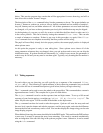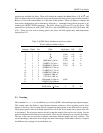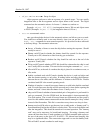
October 30, 1997
9
5.2 Taking Dark Frames
Since thereis no blank positioninthe filter wheel and the shutteris warm, some extra care is required to
obtain reasonable dark frames. With the installation of the second filter wheel, a “LOWFLUX" setting
has been provided. This setting selects two filters simultaneouslywith incompatablebandpasses, e.g.,
the J filter and Br
(2.16 m). This produces a reasonably low flux condition at the array, limited by
the out-of-band blocking of the filters and leakage around the filter wheels.
Another way to get a dark frame is to move halfway between filters on the wheel to block most of the
emission of the warm shutter. Special commands have been provided for doing darks, and a typical
sequence might be as follows:
> filter 2
> filter DARK
> dark 180 Dark Frame
>go5
> filter BACK
This takes 5 180-second dark frames. The dark command works exactly like the object command,
except that the shutter will not open for the exposure. Note you must use the object command
before your next data exposure, or change the default actions with auto, or the shutter will not open!
Also note that you should always do only one filter DARK followed by exactly one filter
BACK, always in pairs, otherwise the filter wheel will get lost and require a filter home.Be
careful, there is no indication from the program when this has happened, as there is no encoder on
the filter wheel. Moving the filter wheel between the J and H filters, as in the example, appears to
minimize the thermal radiation from the warm shutter reaching the detector.
6 Cold Restart
If the power should fail or the DSP computer should need to be reset, the following sequence of
commands should be issued:
>sy
> df quirc
> du util
If this happened during a filter wheel move or pupil mask motion, you will need to reset that with the
filter home or pupil home commands, respectively. Note that the pupil mask re-initialization
can take a long time (up to 30 minutes!) and is a bit tricky. Because of this, observers should never
move the pupil mask unless you are sure it is absolutely necessary–it usually isn’t.
7 Running VF to display data
The VF program is a tool for displaying FITS files, written by Tony Denault for the IRTF. See the VF
manual for detailed information on the program and its capabilities. Its interaction with the qcdcom


















